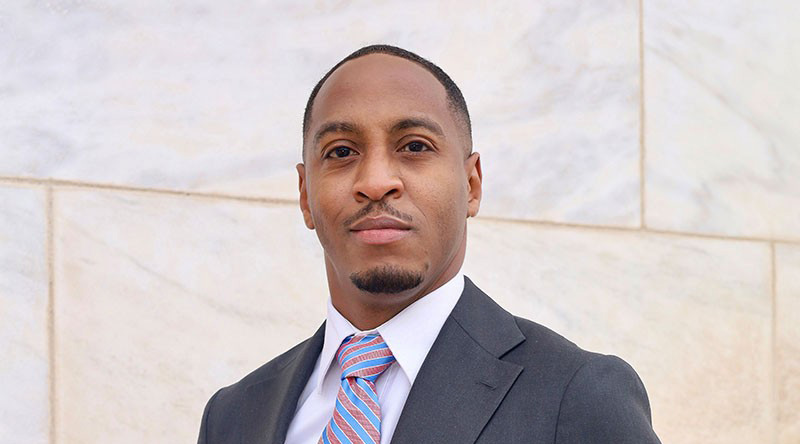Water is arguably our most important natural resource, yet we are seeing communities across the United States struggle for access to clean, plentiful, and affordable water. The Rappaport Center for Law and Public Policy’s Senior Fellow in Residence Jeremy Orr, a leading environmental voice on the subject, painted a picture of the US water crisis from a personal and professional perspective during a community address on March 15 at Boston College Law School.
Orr speaks of water in terms of access, which encompasses the questions of who has it and who doesn’t and whether the water you have access to is safe and secure. These were the concerns Orr and his family had to confront throughout his childhood, and the issues remain to this day. “I know what it feels like to not have water, and no one should have to deal with that. As far as I’m concerned water is a human right,” he said.
Statistics in the US demonstrate a major disconnect between viewing water as a vital natural resource and ensuring that residents have adequate water access. According to the US Water Alliance, more than 2 million Americans don’t have access to running water in their homes, nearly 60 million are exposed to contaminated water coming out of their tap, and an estimated 1 in 20 households have had their water shut off by their local water utility.
Orr shared that he has spent much of his career lifting up and addressing issues of environmental justice, particularly those at the intersection of race and class. “It is easy to leave the work of justice outside of academia; that’s the easy thing to do,” he said.
However, he added, “the work of justice in any form is pretty hard—I know it, and I think you all know it as well—especially when we’re talking about needing to change law and policies, which really means we need to change the minds of our decision makers. We’re talking about changing long-standing, oftentimes governmental, institutions where injustices are systemic and as long-standing as those institutions themselves.”
Orr is the director of litigation and advocacy partnerships for Earthjustice, a premier nonprofit, public interest environmental law organization. Yet he explained that he did not grow up with a love for the environment. Rather, he was raised in Detroit, a city with barriers that kept him from the environment.
“I didn’t grow up with access to cultivated environmental and natural resources that would have made me want to grow up and be somebody who defended and protected the environment,” Orr said. “I grew up in Detroit in the ’80s and ’90s at a time where we really began to see the dire implications of white flight from the city from prior decades”
He recalled city services being cut, including weekly trash pickup, regular snow plowing, and streetlight and public park maintenance. For Orr, the loss of his neighborhood park took away the only intentional exposure to the outdoor environment as a form of recreation.
“I remember growing up in a place surrounded by water [Detroit is within the Great Lakes system], and not having meaningful access to it,” said Orr. “But water is more than recreation; water is life as far as I’m concerned…”
The laws in place do not coincide with Orr’s sentiment that water is a human right. For example, the Safe Drinking Water Act (SDWA) is a law that protects the quality of drinking water and governs more than 90 percent of the US water systems. Orr contended that based on the statistics, SDWA has failed, saying, “As you can imagine, that failure has disproportionately impacted vulnerable communities, particularly communities of color.”
Furthermore, the report of a former colleague titled “Watered Down Justice,” looked at the relationship between social demographic characteristics and drinking water violations and “confirmed what we already knew,” he said.
“Of all those factors studied, race had the strongest relationship to slow and inadequate enforcement of the law. In fact, drinking water in places with the highest population of people of color tended to spend more time out of compliance with the law, for more violations, for more contaminants. And, even when problems were identified and enforcement actions taken, the problems remained uncorrected,” Orr said.
Complicating things further are failing infrastructure, rising water prices, and the privatizations of water systems. “The American Society of Civil Engineers gave America’s infrastructure a grade of a C- in its most recent report, which is up from a D- from a few years ago,” said Orr.
He proposed solutions, including stronger, more protective rules at the federal and state level; transparency and required reporting on certain consumer measures (to improve data collection and availability); and rate reform. Regarding rate reform, Orr noted that there are studies throughout the country that are starting to look at the issue of water cost and affordability in specific states for the purpose of reform.
“The way that we view water—as a commodity—is a long-standing view that has led to the issues we are seeing today,” Orr said. “Water is seen as a commodity to be bought and sold, but it shouldn’t be seen that way. We’ve been paying for it for so long that it’s easy to forget that water is a natural resource in abundance that’s necessary to sustain life. With that, I think it should be available and accessible in its cleanest form to all people.”


